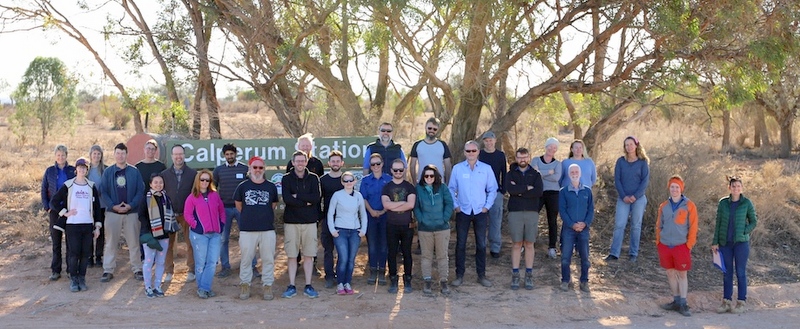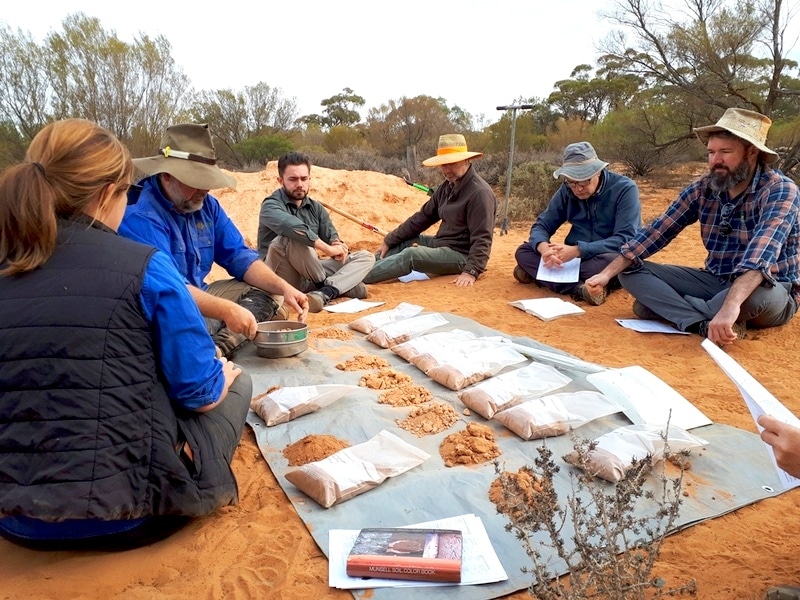Current and next generation ecosystem scientists, managers and volunteers from around Australia were recently trained in TERN’s field survey protocols, acquiring skills and practical inspiration that will support a number of ongoing research, management and community projects.
TERN has successfully completed yet another iteration of its highly regarded field methods training course. In late April, 22 people took part in a week-long workshop at TERN’s Calperum Mallee SuperSite, on Calperum Station near Renmark, South Australia. The purpose was to provide an overview, and hands-on experience, of the field survey apps & protocols used by TERN to monitor soil and vegetation at over 700 field plots across Australia.
Participants spent four days day learning all about the practical and theoretical aspects of plot characterisation, using a range of technologies and recording and collecting vegetation specimens, leaf tissue samples, and soil samples. After an initial theory component on the first day, the focus shifted to a different field aspect each day, allowing for in-depth discussions and practice with a variety of techniques.



The feedback TERN received supports what was observed during the days out and about – that participants enjoyed the opportunity to be in the field, observing the landscape with different lenses and building their knowledge of environmental assessment techniques.
“Congratulations to the TERN staff for organising a comprehensive and state of the art Rangelands Survey course last week at Calperum,” wrote one participant.
“It was an amazing experience and I am both inspired and enthusiastic about the work that is done at TERN and would like to be a volunteer,” said another.
In the lead-up to https://t.co/8QyaS615eb , look at this fascinating tree, it is Desert Poplar, Codonocarpus cotinifolius. TERN Ecosystem Surveillance training at Calperum last week @TERN_Aus identified it for us, yeah! #NCRISimpact, #SolveitwithScience, #STEM pic.twitter.com/dfw2ytmZ7E
— ASPS (@asps_ozplants) May 7, 2019
Soil pit observation at Calperum station @TERN_Aus training pic.twitter.com/gGqbweKtzu
— Maarten Van Helden (@M_van_Helden) May 3, 2019
TERN Ecosystem Observation staff were on hand to assist in demonstrating each aspect of the sampling methodology and ensure everyone had an interactive hands-on experience.
“Calperum Station, a property of internationally recognised Ramsar wetlands, is a great site for such an exercise, given it encompasses a range of landscape types, including red sand dunes, riverine floodplain, mallee woodland, open forest, samphire flats and chenopod shrubland,” says TERN’s Sally O’Neil.
“Groups rotated around three plots so that by the end of the training all aspects had been recorded for all sites.”
The hot tips keep rolling in at @TERN_Aus #TERNtraining2019 with Senior Botanist and Field Lead Emrys Leitch showing participants the ropes, or rather tapes, recommending our favourite type and brand for #ecologysurvey #STEM pic.twitter.com/hnG1HlsQEt
— Sally O'Neill (@one_sal) April 30, 2019
TERN would particularly like to thank the Australian Landscape Trust, which manages Calperum Station, for making available their excellent facilities, and the station staff for providing firewood for relaxing evening fireside discussions.
Keep an eye out in the TERN eNewsletter and on our Twitter and Facebook feeds for announcements on upcoming training opportunities with TERN. We look forward to welcoming you to one of our research infrastructure sites in the near future.
- For information about TERN’s Ecosystem Surveillance platform and how you can use its data and samples, explore the TERN website.
- The TERN AusPlots Survey Protocol manual is available for free download here.
#gamechanger Sometimes it is the little things that make a difference. Flagging tape tied to a peg means less plastic, more re-use, less twigs and vegetation broken off! @TERN_Aus #TERNtraining2019 #ecology #surveymethods #STEM pic.twitter.com/5t3lXxUwPr
— Sally O'Neill (@one_sal) April 30, 2019
When @TERN_Aus started collecting data in remote #Australia, all data had to be recorded by hand. Nowadays all plot data can be recored and saved using apps developed specifically for our collection processes. It helps increase our efficiency and data quality. pic.twitter.com/6iCt2zKq0W
— Samantha Munroe (@SEM_Munroe) April 30, 2019
Morning tea break in the sun on day 1 of the TERN Surveillance Field Methods Workshop. @TERN_Aus pic.twitter.com/jeuYlM35EQ
— Angela Gackle (@AngieGack) April 29, 2019
At calperum station with @TERN_Aus doing a TERN surveillance field training workshop. #CalperumStation pic.twitter.com/wWjdRbv1Jy
— Annie Grace Kraehe (@AnnieGKraehe) May 1, 2019






